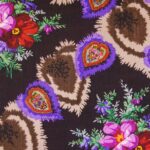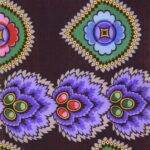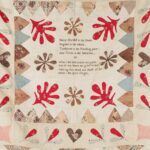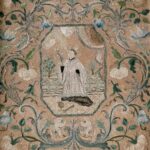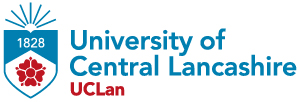This sample is one of a set of over 90 print samples attributed to the Robert Hindle & Co Print Works in Sabden, Lancashire. The vibrant colours of the samples are a perfect example of the impact that aniline dyes had on the dyeing and printing industries. The first aniline dye was mauveine or ‘Perkin’s […]
View moreThis sample is one of a set of over 90 print samples attributed to the Robert Hindle & Co Print Works in Sabden, Lancashire. The vibrant colours of the samples are a perfect example of the impact that aniline dyes had on the dyeing and printing industries. The first aniline dye was mauveine or ‘Perkin’s […]
View morePatchwork and appliqué coverlet made from printed cottons by Nancy Horsfall for her wedding in 1833. The design uses a typical early 19th century frame layout with a central section of finer, smaller scale piecing and appliqué that would have been the most visible part on the flat top of the bed. The edges are […]
View morePanel of laid work embroidery with a design of peacocks and an urn of flowers, worked by Rachel Kay Shuttleworth in 1921. This framed panel of embroidery is worked in a technique known as laid work where long stitches are laid down first to fill in the shapes and then secured with smaller couching stitches […]
View moreA Chamba rumal of cotton muslin embroidered in colourful silk threads with a design depicting four figures on horseback and floral borders. Chamba rumal embroideries take the first part of their name from the small town of Chamba in the Himachal Pradesh region of India and began being produced there in the 17th century. The […]
View moreA framed colifichet embroidery depicting St Aloysius de Gonzaga worked in fine silk floss on a ground of parchment. Colifichet embroideries are a rare type of double-sided embroidery that are stitched meticulously so that each side appears the same. As shown in this example, they were usually specially framed so that both sides of the […]
View more